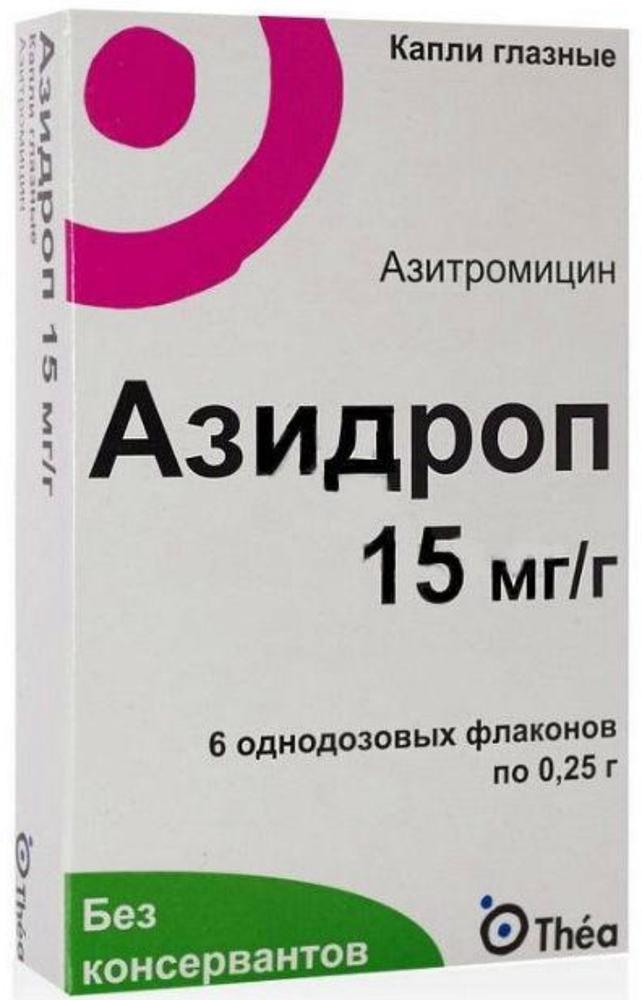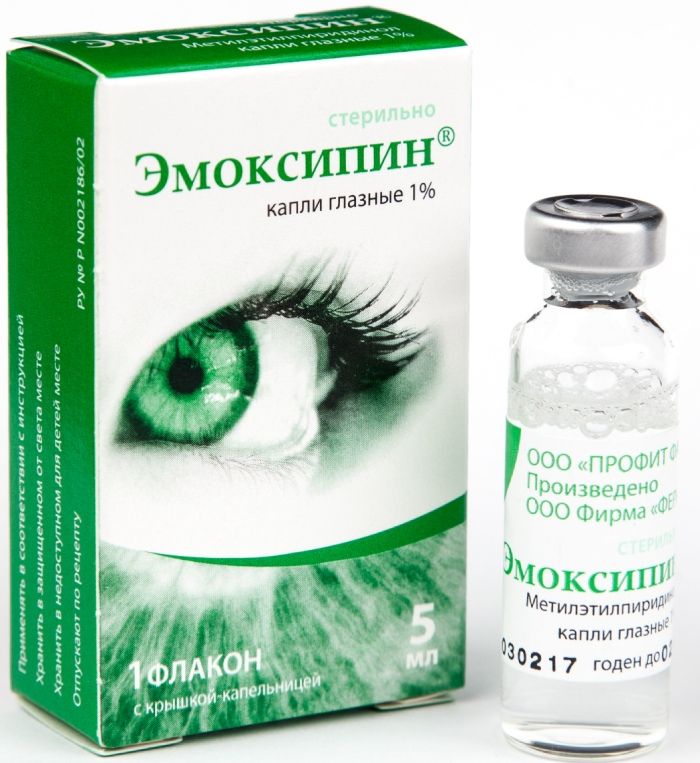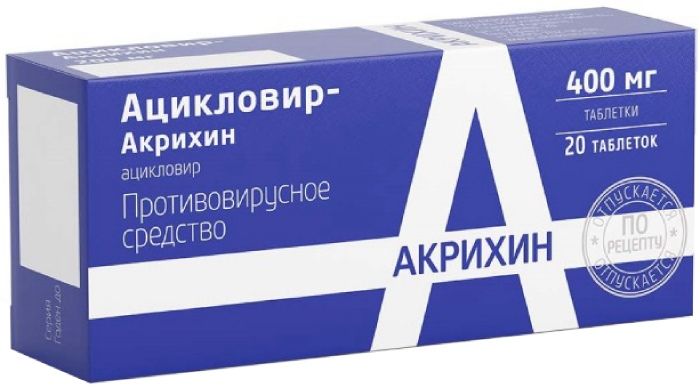- No products in the cart.
Azidrop drops Ch. 15mg / g of 0.25g fl 6 pcs
$8.59
Azidrop drops Ch. 15mg / g of 0.25g fl 6 pcs
Description
Composition
Active substance:
1 g of the preparation contains: 15.0 mg azithromycin dihydrate (converted to 14.3 mg of azithromycin) ;.
Excipients:
Medium-chain triglycerides and 1.0 g
Description:
Transparent oily liquid from colorless to pale yellow.
Product form:
Eye drops, 15 mg / g. 0.25 g in monodose vial clear colorless low density polyethylene. 6 vials soldered together in the form of tape. By tape 1 in a hermetically sealed package made of paper / polyethylene / aluminum foil. 1 package together with instructions for use in a cardboard package.
Contraindications
Hypersensitivity to azithromycin and other macrolide antibiotics, as well as the drug component.
Dosage
15 mg / g
Indications
Is indicated for the local antibiotic treatment of conjunctivitis caused by susceptible microorganisms (see “Pharmacodynamics” and “Cautions”.)
Purulent bacterial conjunctivitis in children (from birth to 17 years) and adults
Trachomatous conjunctivitis caused by Chlamydia trachomatis, in adults and children (from birth to 17 years) (see. Also subsection “Newborn” section “Special Instructions”). Should take into account the recommendations of the official guidelines on the appropriate use of antibacterial agents.
Interaction with other drugs
Special studies of drug interactions drug Azidrop not conducted. In the absence of azithromycin concentrations determined in plasma during instillation of eye drops Azidrop (see. The section “Pharmacokinetics”), interaction with any of the drugs that interact with azithromycin when administered latter is expected. In the case of concomitant treatment with other ophthalmic drugs, the drug Azidrop Bury least, 15 minutes after instillation of another drug.
Overdose
The content of azithromycin in a package for a single application is sufficient to treat both eyes but not sufficient for the occurrence of adverse reactions when administered intravenously or accidental ingestion of solution.
pharmachologic effect
Pharmacological group:
Antibiotic-azalide.
Pharmacodynamics:
Mechanism of action
Azithromycin – macrolide antibiotic from the group of second-generation azalides. Inhibits protein synthesis in bacteria, by contacting the 50S-ribosomal subunit and preventing translocation of peptides.
mechanism of resistance
Note the three resistance mechanisms for different kinds of bacteria to macrolides: target modification resulting action of the antibiotic or modification through the active release of an antibiotic from the microbial cells by transportation systems (efflux). For bacteria describes various efflux system. Important efflux system for streptococci mef-encoded gene and results in limited resistance macrolide (M-phenotype). Modification of the action target, controls erm encoded methylase (MLSV phenotype) leads to cross Resistance to the different classes of antibiotics (see. Below). There are cases of cross-resistance to erythromycin, azithromycin, other macrolides and lincosamides and streptogramin B for Streptococcus pneumoniae, beta-hemolytic streptococci group A, Enterococcus spp. and Staphylococcus aureus, including methicillin-resistant S. aureus (MRSA). Constitutive mutants in inducibly resistant strains with erm (A) or erm (C) may be isolated in vitro at low frequencies ~ 10-7 cfu in the presence of azithromycin.
borderline significance
The following shows the minimum inhibitory concentrations (MIC) for the microorganisms during data indications (cm. “Indications” section). It should be noted that these lower border MIC values and the spectrum of action apply to system application. These MIC can not be used in case of topical treatment with eye drops due to other concentrations and himicheskix physicochemical conditions that may affect the overall activity of the drug at its site of action. In accordance with EUCAST (European Committee for the determination of sensitivity to antibiotics) to the following border azithromycin MIC values are determined in mg / l: – Haemophilus influenzae: S 4 mg / l – Moraxella catarrhalis: S 0,5 mg / l – Neisseria gonorrhoeae: S 0.5 mg / l – Staphylococcus spp *: S 2,0 mg / l – Streptococcus pneumoniae: S 0,5 mg / l – Streptococcus A, B, C, G: S 0,5 mg / l * spp includes all species of the genus EUCAST allows the use of erythromycin for the determination of the sensitivity of other species of these bacteria to azithromycin. The frequency of acquired resistance for the individual types can vary depending on the geographic region and time. In this regard, it is desirable resistance local information, particularly in the treatment of severe infections. If necessary to consult a specialist when the local frequency resistance is such that the effectiveness of the drug, at least in certain types of infections, is questionable.
Antibacterial spectrum of azithromycin bacterial species for reading data
Species usually sensitive to the drug:
Aerobic gram-negative bacteria: Moraxella (Branhamella) catarrhalis, Neisseria gonorrhoeae, Haemophilus influenzae, Haemophilus parainfluenzae
Other microorganisms: Chlamydia trachomatis
Impermanent sensitive species:
Aerobic gram-positive bacteria: Staphylococcus aureus (methicillin-resistant and metitsillinchuvstvitelny), Staphylococcus, coagulase (methicillin-resistant and metitsillinchuvstvitelny), Streptococcus pneumoniae, Streptococcus pyogenes, Streptococci viridans, Streptococcus agalactiae, Streptococcus group G
Species with natural resistance:
Aerobic gram-positive bacteria: Corynebacterium spp, Enterococcus faecium.
Aerobic gram-negative bacteria: Pseudomonas aeruginosa, Acinetobacter, Enterobacteriaceae
Information about clinical trials
Trachomatous conjunctivitis caused by Chlamydia trachomatis.
A randomized, double-blind, comparative study of the duration of 2 months of preparation Azidrop with oral administration of a single dose of azithromycin for the treatment of active trachoma in 670 children aged 1-10 years. The primary efficacy variable was the clinical cure at Day 60, ie, absence of active trachoma TF0 (simplified by classifying the severity of trachoma WHO). On day 60 clinical cure rates Azidropom, 1 drop applied 2 times a day for 3 days was not lower (96.3%) than when azithromycin inside (96.6%). Clinical efficacy Azidropa, apply 1 drop of 2 times daily for 3 days for the treatment and prevention of trachoma entire population (from birth) in North Cameroon (112,000 subjects) evaluated in a multicenter, open, comparative study not phase IV. Treatment was carried out 3 periods of 1 year. The primary efficacy criterion was the prevalence of active trachoma, i.e. trachomatous follicular inflammation or inflammation expressed trachomatous (TF + TI0 or TF + TI +). To analyze the clinical assessment of trachoma performed each year in 2400 children aged> 1 and
Purulent bacterial conjunctivitis
A randomized, blind comparative study Azidropa, 1 drop applied 2 times a day for 3 days with tobramycin, eye drops, 0.3%, applied to 1 drop every 2 hours for 2 days and then 4 times a day for 5 days for the treatment of purulent bacterial conjunctivitis in 1043 patients (group of the ITT), including 109 children under the age of 11 years, 5 of which were infants (0 to 27 days), 38 infants and toddlers (28 days up to 23 months). According to the protocol population (n = 471) (PP group) comprised 16 infants and toddlers and infants are not included. Clinical studies were conducted in different regions of Europe, North Africa and India. The primary efficacy variable was a clinical cure at Day 9 in the PP group and is defined as 0 points for injection of the bulbar conjunctiva, and purulent discharge. On day 9 Azidropom clinical cure rates (87.8%) was not lower than with tobramycin (89.4%). Microbiological efficacy of azithromycin was comparable to that of tobramycin
Pediatric population
The efficacy and safety Azidropa in children under the age of 18 have been shown in a randomized study with masking researcher compared with tobramycin in 282 study patients with a diagnosis of purulent bacterial conjunctivitis (including 148 patients in the subgroup 0 days –
Pharmacokinetics:
After instillation of eye drops Azidrop in treating bacterial conjunctivitis in the recommended dose of azithromycin is not detected in the patients blood (detection limit: 0.0002 g / ml plasma). Children A pharmacokinetic study conducted in adults only.
Pregnancy and breast-feeding
Pregnancy
Since the systemic exposure of azithromycin is negligible, the harmful effects of the drug during pregnancy is not expected. Application Azidrop drug, eye drops in pregnant possible.
Breast-feeding
There is limited evidence that azithromycin passes into breast milk, but, considering the low dose and the low systemic availability, the dose ingested by infants, is negligible. Thus, application of the drug Azidrop breastfeeding acceptable.
fertility
Data from animal studies have not confirmed the effect of azithromycin on the fertility of men and women. The results of studies in humans. Since the systemic exposure of azithromycin on the body slightly, the effect of the drug on fertility is not expected.
Conditions of supply of pharmacies
On prescription.
side effects
During clinical studies and post-marketing according Safety Data Azidrop drug, eye drops were observed following treatment-related adverse reactions:
Violations by the immune system
Infrequently (> 1/1000,
Violations by the organ of vision
Very common (> 1/10)
Ocular discomfort (pruritus, burning, stinging) upon instillation of the drug.
Often (> 1/100,
Infrequently (> 1/1000,
Adverse reactions that were not observed during clinical trials.
Turning reduced adverse reactions based on post-marketing data. The frequency is determined, starting from 3 / X, where X is the total sample size, summed over all relevant clinical studies which at 3/879 gives the category of “rare”.
Violations by the immune system
Infrequently (> 1/1000,
Violations by the organ of vision
Infrequently (> 1/1000,
The profile of adverse reactions in children corresponds to the adult population, no side effects were detected. The safety profile for the different pediatric groups was also identical (see. Forums “Pharmacodynamics”).
special instructions
Eye drops should not be administered by injection or swallowed. Eye drops can not be administered in the form of peri- and intraocular injection. When an allergic reaction to the drug treatment should cease. Patients should be informed that we should not continue instilled eye drops after the completion of a three-day course of therapy, even if residual signs of bacterial conjunctivitis remain. Relief of symptoms typically occurs within 3 days. If there are no signs of improvement after 3 days, the diagnosis should be reconsidered. Patients with bacterial conjunctivitis should not wear contact lenses. Against the background of systemic use of azithromycin reported cases of fulminant hepatitis, which can potentially lead to life-threatening liver failure. In applying the drug in ophthalmology such a risk does not exist, since the systemic exposure of azithromycin is extremely low (see. Section “Pharmacokinetics”).
Children
Comparative studies of the efficacy and safety of the drug when trachomatous conjunctivitis in children younger than 1 year were not conducted. However, taking into account the experience of the clinical use of children in this age group at trachomatous conjunctivitis and the experience of therapy with Azidrop newborn children with purulent bacterial conjunctivitis, security concerns and the differences in the pathological process, allowing to exclude the application of eye drops Azidrop in children under the age of one year on the indications for use are lacking.
Newborn
According to current international guidelines for the treatment of eye diseases and urinary tract, which can be highly likely to be transmitted to newborns, conjunctivitis netrahomatoznogo origin, called by Chlamydia trachomatis, and conjunctivitis, the called Neisseria gonorrhoeae, the need for systemic therapy. In infants and children under the age of 3 months of systemic infections (such as pneumonia and bacteremia) caused by Chlamydia trachomatis, may be accompanied by conjunctivitis. If you suspect that such conditions requires systemic therapy. The drug is not intended for the prevention of bacterial conjunctivitis in the newborn
Effects on ability to drive and use machines
Effects on ability to drive and do not study the mechanism. After applying an eye drop can be observed transient blurring of vision. In this case, drive vehicles or operate machinery to restore vision is not recommended.
Storage conditions
In the dark place at a temperature of 2 to 8 C.
Keep out of the reach of children.
Dosing and Administration
adults
Instilled one drop into the conjunctival sac of the affected eye twice a day (morning and evening) for three days. If there is no positive dynamics within 3 days of the drug, should consult a physician to review and diagnosis and treatment regimen.
elderly
No dose adjustment is required.
children
No dose adjustment is required (see. Forums “Pharmacodynamics” and “Cautions”).
Route of administration
Instilled into the conjunctival sac of the affected eye. Patients should follow these guidelines: You must wash your hands thoroughly before and after instillation of the preparation procedures, you should not touch the eyes and the tip of the dropper bottle of the century, after a single use vial must be discarded along with the available balances. You can not use the remainder of the solution in the vial for the next instillation.
Information
Appearance may differ from that depicted in the picture. There are contraindications. You need to read the manual or consult with a specialist
Additional information
| Weight | 0.100 kg |
|---|---|
| Manufacturer | TEA PHARMA |














There are no reviews yet.